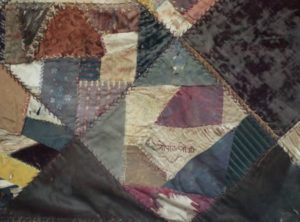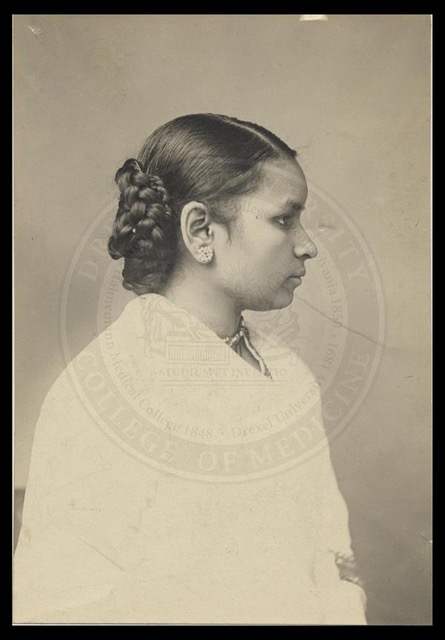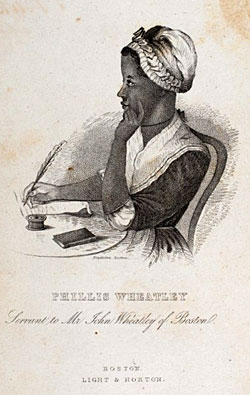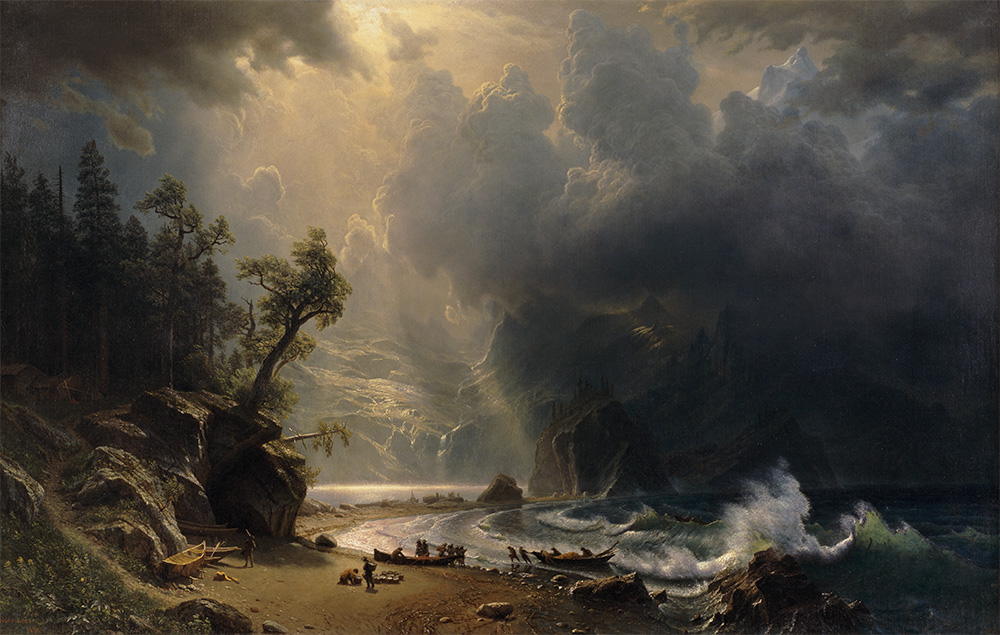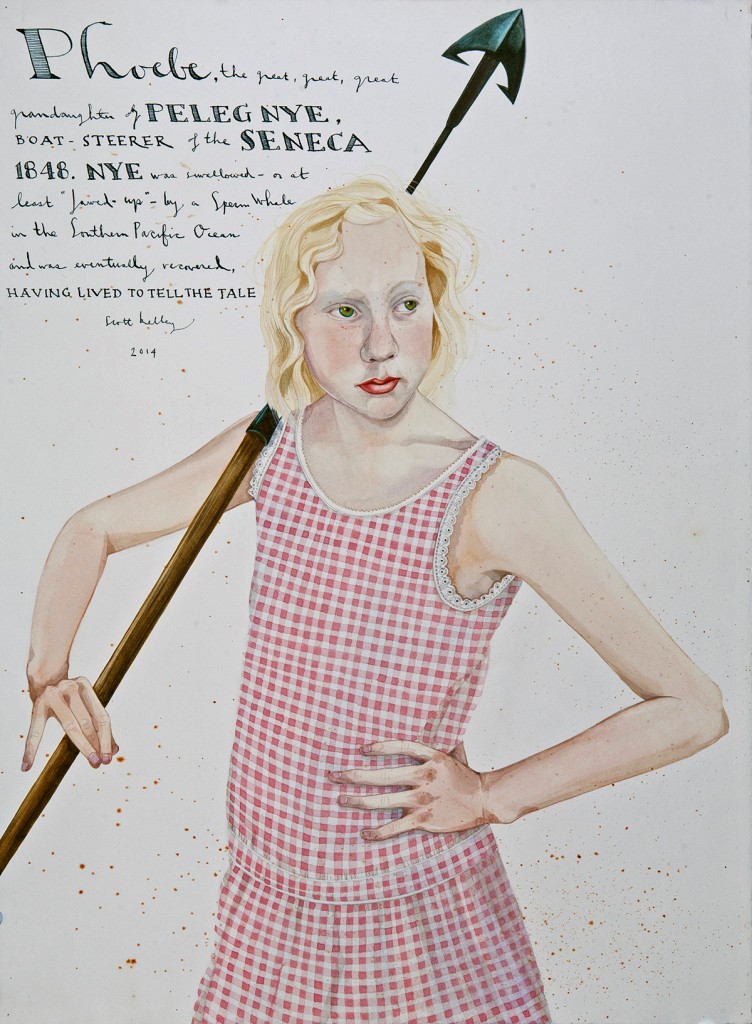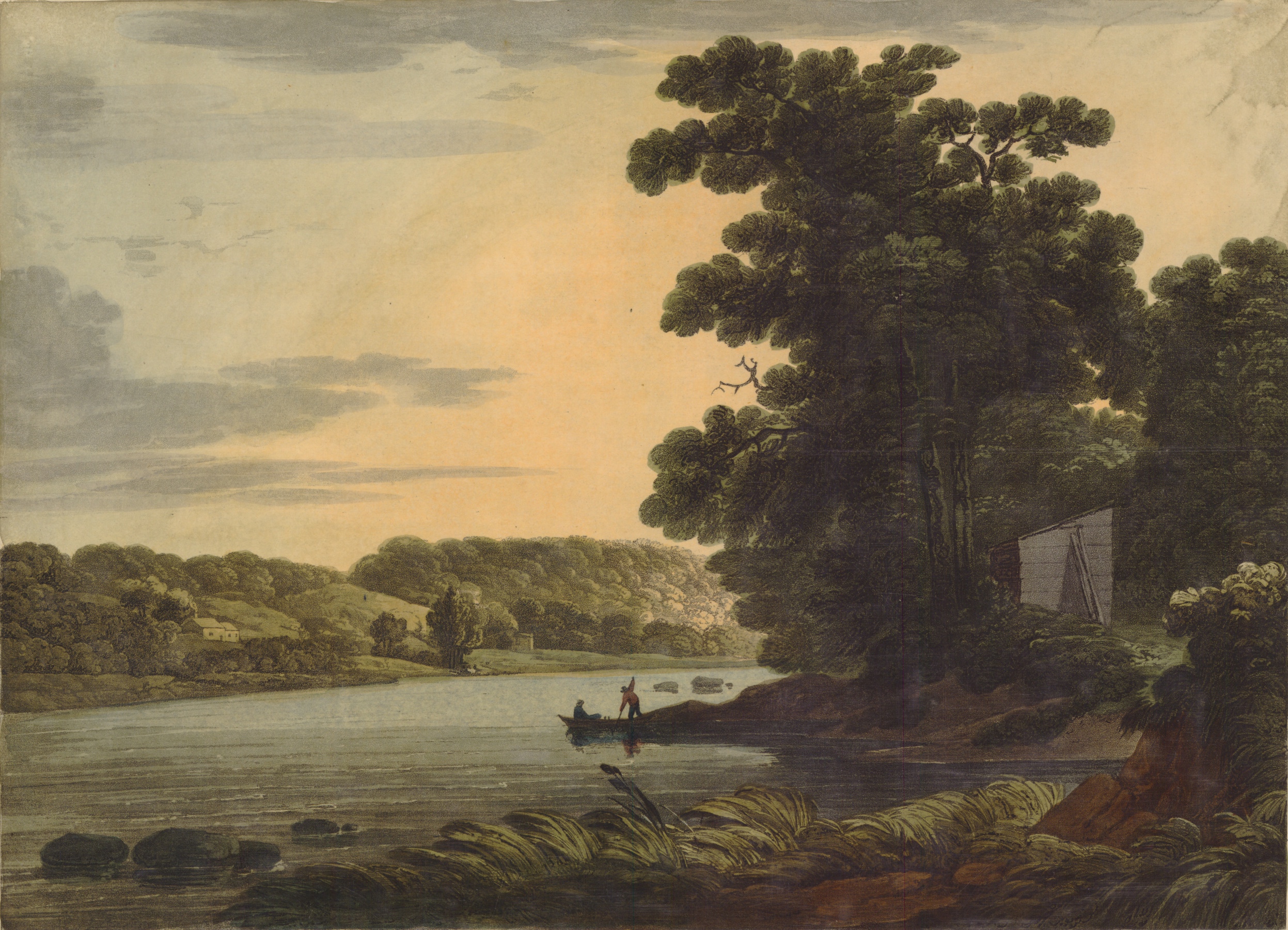Statement of Poetic Research
“If not yourself, whom would you like to be? No one.”
—Anandibai Joshee, 1883, from a mental photograph in Theodocia Carpenter’s autograph book, New Jersey.
In 2017, I was researching South Asian history for a long lyric poem I was writing on the racism I had experienced as a child while growing up in Minnesota in the early 1980s. In this poem, I wanted to confront a childhood bully with facts and dazzle him, to let him know that my family wasn’t the first to have come from India, so that his words, “go back to where you came from,” would ring hollow. It had always been convenient for me to slip into the notion that I was the “other” and that America wasn’t my actual home because I hadn’t seen myself or my history reflected in my surroundings. This led me on a wild goose chase of sorts to find out who was the first woman from India to touch American shores. And suddenly there she was, seated in a sepia-tinted photograph, next to two other women, dressed elegantly in a saree, her Mona Lisa-like glance following me everywhere, her lips curled up in a half-smile, her image radiating such fierce determination that I had to know more. Who was this woman and how did she get to Philadelphia all alone from India in the nineteenth century and why? How did she break away from that iron grip of tradition where women were largely homebound tending to family and manage to cross kala pani, those black ocean waters that were considered tainted? I was riveted and literally felt a shiver—of acknowledgment and discovery, this validation of knowing that all along there had been others before us. This was how I stumbled upon the extraordinary life of Anandi Gopal Joshee, known more informally as Anandibai (bai, a term of respect for Marathi women), the first Indian woman to have come to the United States to pursue a medical degree in 1883. Until very recently, Anandibai’s story was limited to her geographic community in India and had been told through the lens of her husband being her advocate and guide. I wondered if I were to tell Anandibai’s story through poems in her own voice, what would that mean? How would it change the narrative? Would it give her agency back to her? Would it give South Asian Americans a deeper sense of roots and history? And supposing it did, was I the right person to undertake this task? I was a poet after all, and not a historian.
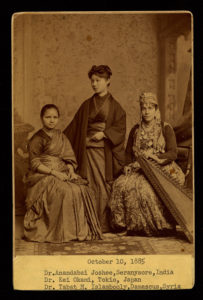
It is with these hesitations that I began my research and poem-making. And stopped. And started. And stopped. And began again. For four years, Anandibai would simmer in the back of my mind like a pot of dal on the stove. I was intimidated by what I found and what I hadn’t. There was a biography written in Marathi, Anandibai’s mother tongue, of which I barely knew a few words. There was also a Marathi novel that had been translated into English that captured the era well, but painted a picture of Anandibai that seemed weak, helpless, and at the whims and mercies of her mercurial husband. It barely mentioned Anandibai’s time in the United States. Drexel University’s Legacy Center Archives brought me a little closer to the person that was Anandibai. It was here that I came across that iconic photograph of three women from three different countries posing in their native dress—a saree, a kimono, a headdress of coins—gathered in Philadelphia to become doctors and then return home to serve the people of their respective lands. (Figure 1) Yes, this photograph echoed exoticism, orientalism and the West’s fetishization of the East, and yet it exuded a kind of power that seemed to turn the notion of empire on its head and hint at an allyship and sisterhood that went beyond the church and state. The image had gone viral in 2017, but there were more photos of Anandibai. One, a side profile with her signature in both Devanagari and English (Figure 2), and a letter in her long, slanted writing stating why she would be an ideal candidate for medical school, a newspaper clipping celebrating the arrival of the first woman medical student from India, and more. She was becoming more real by the second. Yet every twenty-first century article on Anandibai I came across espoused the same narrative:
India’s first woman doctor. Born in 1865. Married at nine to a widowed man sixteen years older who was zealously progressive. Pregnant at twelve or fourteen, Anandibai loses her child (a son) ten days after giving birth due to lack of medical care. The loss fuels her desire to become a doctor, only there are no medical schools for women in India. Anandibai’s husband does everything he can to help her become one, including pleading with American missionaries and possibly converting to Christianity. An American woman in New Jersey hears of Anandibai’s plight and offers assistance. Anandibai goes to America, all by herself, despite the protest of her own countrymen and women. Anandibai returns to India as a doctor and is celebrated/hailed for her bravery but dies of tuberculosis before she can practice.

So where was Anandibai in all of this? Trapped between the narrative of the husband as savior and the white wo/man as savior was Anandibai’s own voice and it resounded so loudly in my mind and heart. Could no one else hear it?
Two women, a century apart, had heard Anandibai’s voice and had tried to capture it in their own ways in English. The first, Mrs. Caroline Healy Dall, a feminist writer and reformer, had met Anandibai while she was in America and after their first meeting had written in her journal:
She looks like a stout, dumpy mulatto girl not especially interesting until her yellow face lights up, and light up it did as soon as she gathered from a helping word of mine, that I was familiar with the customs of her people. I cannot describe the effect. It was magical. She speaks seven languages, of which English, Sanscrit and Mahratta are three. Her English is exquisite. There is hardly a flaw in pronunciation or construction. If I had not known, I should have thought her born in this country.
On first reading, I found the journal entry offensive, and it brought back memories of my own childhood where I was told how flawless my English was by white Americans, marveling at how I didn’t have an accent. But on closer examination, I was fascinated by the paradoxes within the journal entry. Anandibai had clearly made an impression on Caroline Dall. So much so that she would meet Anandibai several more times and go on to write her biography within a year of her passing. While this was a biography of an Indian woman through Western eyes and carried the author’s own cultural biases, it incorporated several of Anandibai’s letters along with comments from those who were close to her along with a narration of incidents and events. Anandibai’s voice was on almost every page through her letters that Dall had collected from various people—a polite and trusting voice, a strong and confident voice, a voice that wasn’t afraid to ask questions and share her concerns, a voice that seemed wise beyond her teen years. Best of all, this book, The Life of Dr. Anandabai Joshee, A Kinswoman of Pandita Ramabai, written in 1888, was available on the internet, copyright free. I downloaded and printed it twice in four years, between the several stops and starts of this project. This would be my go-to book, as I read it repeatedly, scanning for nuggets of gold, a chance sentence or fact that might reveal a unique facet of Anandibai’s personality or experience. Anandibai had visited Tiffany’s flagship store in New York. She had also gone to the Barnum & Bailey Circus show with a classmate and had written that she didn’t care for it, but hadn’t specified why. In 1883, Anandibai held an Indian feast for her host family and their friends where the women all dressed up in Anandibai’s Indian clothes and sat on the floor eating with their hands. She had even given her host and her daughters Hindu names, and they had remarked they were all turning into Hindoos. Anandibai’s favorite color was white, her favorite place Roselle, New Jersey, and after that, heaven. This she shared in an autograph book at her host’s home. It was the smallest details I was looking for and this biography offered them.
The other book I would turn to was published more than a century later, A Fragmented Feminism: The Life and Letters of Anandibai Joshee by Meera Kosambi, published in 2020. Meera Kosambi was an Indian sociologist who, like me, was in search of the real Anandibai. Like Anandibai, Kosambi was also from Maharashtra and had access to works and letters in Marathi. She also had access to Dall’s biography and drew much from it. Kosambi brought her own critical analysis and questions to the fold, pointing out how Anandibai’s husband’s ideas of reformation were contradictory and that it was only through the distance of many oceans that Anandibai could come into her own and see that her relationship with him was a difficult one, among other things. With her scholarship, Kosambi connected the dots that Dall never could have. And yet I still felt that something remained to be said. Both these women had captured Anandibai’s life; one with a nineteenth-century Western reformer perspective, the other looking more deeply through a twenty-first-century Indian feminist lens, with Anandibai’s words to support their respective theses.
Perhaps poetry was the medium that could fill the critical gap between these two important representations of who Anandibai Joshee was, especially if it was poetry imagined in “her” own voice, from a woman who had inhabited both worlds, a person who had lived both in India and the United States, a woman who, like Anandi, had been torn between traditional expectations and the desire to find out who she was, apart from what others expected her to be. I second-guessed my intentions and yet I continued amassing a small pile of facts and images, as the task lay before me of how to translate a woman’s life into poems. How much to show, how much to tell, and how much to discern from what was between the lines? How much research was enough? I looked to others who had undertaken the monumental task of bringing voices of the past to light and drew inspiration from the poems of Tyehimba Jess, who in his extraordinary polyvocal book, Olio, had given voice to unrecorded African American performers in the eighteenth and nineteenth century in innovative ways and forms I had never seen before. In searching for women’s voices through historical persona poetry, I discovered Dominique Christina’s searingly powerful book, Anarcha Speaks: A History in Poems, in which she gives voice to Anarcha, a nineteenth-century enslaved black woman on which Dr. J. Marion Sims, the so-called father of modern gynecology, performed horrific experiments in the name of science. Later in my journey, I would come across Honorée Fanonne Jeffers’ The Age of Phillis, a collection of poems and scholarship that took my breath away in its retelling/imagining of the life of Phillis Wheatley Peters, the very first African American woman who wrote and published a collection of poetry in the eighteenth century. (See Jeffers’ Commonplace piece here)
As I pondered and processed all of this, the pandemic broke out and raged. My life came to a standstill, while Anandibai’s came alive. In the quietness of a sequestered world, I was able to let the past in. The poems started coming out in a voice that didn’t seem like mine—quiet, contemplative, slightly formal, but insistent. To my astonishment, in the span of nine months, I wrote over forty poems, all in the imagined voice of Anandibai. Had she finally come through? The interiority of such undertakings is often part of a solitary journey. But during a pandemic, it felt like living a whole other life despite being grounded. I am eager to share what I have discovered and written, to let Anandibai’s voice and story touch everyone, to reclaim the past in a bid to understand better who we are. I hope you will join me.
THEY CALL ME LADY OF THE ORIENT
Philadelphia, September 1883
Though the darkest one in the room, I’m the brightest of them all
in a red Pitambar saree deemed Pompeiian, belle of this ball—
and as I shake their hands, five hundred pairs, wearing gloves to protect me
they regard the spray of pearls hanging from my nose, my filigreed wrists
of bangles glinting gold, the tiny kunku dot on my broad forehead
drawing stares and praise, for this young Brahmin lady so brave
having come all the way alone from Serampore to the city of brotherly love
to earn her doctor’s coat. Majhe nav Anandi aahe, I want to say in my native tongue
so that I don’t forget who I am, the young girl whose books once lay tattered
in the cowshed, whose baby lived barely ten days—I float like an Indian rose
among a dull sea of cinched waists and bonnets, in the parlor of the Dean
of the Women’s Medical College, smiling till my cheeks hurt as they stumble
out a new version of my name, Ananda Bye, remarking how exquisite is my English
Kunku/kumkum (Marathi/Hindi): A red powder dot worn by married Hindu women in the part of their hair or forehead
Majhe nav Anandi aahe ((Marathi): My name is Anandi
A MENTAL PHOTOGRAPH
A found poem from Anandibai Joshee’s entry in Mrs. Theodocia Carpenter’s Autograph book
September 3rd, 1883
I was ravenous
shoving the open mouth
of my mind with morsels
of knowledge held
by my husband’s hand
that after crossing two oceans
when I should be asked in the parlor
of my sponsor, a kind American woman
whom I call Mavshi—mother’s sister
in my native tongue, but whose love is
like a mother’s itself—what my favorite things are
I am truly overcome with joy
no one has ever asked this of me
(Not even I), And so I write
in the album of Mrs. Theodocia Carpenter
of Roselle, New Jersey, ever so carefully
answers that introduce me
to myself
Color—White.
Flower—The Rose.
Tree—The Mango.
Object in Nature—Mountains.
Hour—Sunrise and set.
Season—Spring.
Perfume—Jasmine.
Gem—Diamond.
Style of beauty—Perfection of form and manner.
Name, male and female—Rama, Tara, Annie, Gopal, Vishnu, and Chrishna.
Painter—I love all.
Musician—Those who play on the violin and lyre.
Piece of architecture—The Taj Mahal.
Poet—Pope, Manu, and Kalidasa.
Poetess—Muktabai and Janabai.
Prose author—Goldsmith, Macaulay, Addison, Shastree Chiploonkar.
Character in History—Richard Coeur de Lion.
Book to take up for an hour—The Bhagavat-Gita
What book, not a Bible, would you part with last? The History of the World.
What epoch would you prefer to live in? The Present.
Where would you prefer to live? In Roselle now, hereafter in Heaven.
What is your favorite amusement? Reading.
What is your favorite occupation? Whatever is necessary to the common comfort.
What is your favorite trait of character? Sincerity.
What trait do you most detest? Dishonesty and infidelity.
If not yourself, whom would you like to be? No one.
What is your idea of happiness? Faith in God.
What is your idea of misery? To follow one’s own win.
What is your bête noire? Slavery and Dependence.
What is your ideal pleasure: To be rewarded for what I do.
What is your distinguishing characteristic? I have not yet found out.
That of your husband? Benevolence.
What is the sublimest passion? Love.
What are the sweetest words? Love, charity, truth, and hope.
What are the saddest? Lost, forsaken.
What is your aim? To be useful.
What is your motto? The Lord will provide.
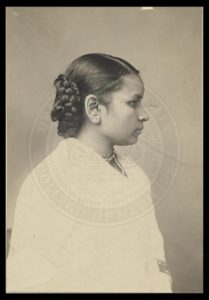
A DRESS FOR ANNIE
Favorite Name, Male and Female—Rama, Tara, Annie, Gopal, Vishnu, and Chrishna.
-From a mental photograph of Anandibai Joshee in Mrs. Theodocia Carpenter’s Autograph book, Roselle, New Jersey, 1883.
1883
Sometimes I wonder what might it be like
to don a bonnet, my black hair twisted into coils
fringing my forehead, and the corset though it looks
most uncomfortable, would define my waist more
what might be the color of the dress to go with it
what type of ruffles and how big the bustle?
and what if they called me Annie instead of Anandi?
Aunt tells me time and again to wear hers
Though she is taller and larger than I am
I have lifted her dress in my arms
dancing with it as if a ghost, but never
have I worn a western dress, and if ever
it were to be, I should wear my kunku, mangalsutra and bangles
for without them, I would feel my worth forsaken
what I fear most is the ridicule, and also the thought
that I might actually like it, and then what will I tell him—
he whose letters arrive from thousands of miles away
informing me I have changed, though he is not my witness
Kunku/kumkum (Marathi/Hindi): A red powder dot worn by married Hindu women in the part of their hair or forehead
Mangalsutra (Hindi/Marathi): Auspicious thread/necklace in Hinduism, which a groom fastens on his bride during their marriage ceremony signifying the joining of two souls.
WHEN THE GUESTS SUP AS GODS: A GHAZAL
Roselle, New Jersey, 1883
In my wildest dreams, never do I fathom tonight
that I should turn them into feasting Indians tonight
not those whose vast plains they call their own
but proud Mahrattas from my faraway native tonight
all the fair ladies draped in woven bordered sarees
hands bangled, necks spangled, shining bright tonight
as they swish across the inlaid floor like princesses
in my colorful trousseau that belongs to them tonight
eighteen squares hand-drawn in red and white powder
on the dining room floor where guests sup as Gods tonight
set with plates stitched from broad buttonwood leaves
a rich meal of spiced vegetables and fruit await all tonight
after a Sanskrit prayer blessing this feast is chanted
all eyes look up to me on how to proceed tonight
no spoons, no forks, nor knives, just their pale bare hands
sampling eighteen exotic dishes prepared by myself tonight
fashioning small balls out of their food with pink fingertips
they pop them into their mouths like all of India does tonight
the meal ends with a serenade and sprinkling of rosewater
bouquets of freshly plucked flowers given to each guest tonight
Oh Anandi, see the red kunku on all their white foreheads
how the love of my new sisters makes this heart swell tonight
Mahrattas: A member of the upper castes of the Hindu kingdom of Maharashtra in central India.
Kunku: A red/vermillion powder worn on the forehead of Hindu women as a symbol of being married
A DISTINGUISHED BRAHMIN LADY VISITS TIFFANY & COMPANY
New York City, 1883
With a lurch and clop of the horsecar, we are off to take in the sights of the city, its hustle and bustle stirring my heart, reminding me of home. We are riding through the Ladies Mile at Union Square, New York, and everywhere my eyes rest—women dressed so fine, their bonnets bobbing, and corsets cinched tight. This is where the American gentry come to purchase garments and sundry and window-shop at stores like Lord & Taylor, Siegel-Cooper, and Macy’s. I am a speck among these massive multistory buildings of iron, glass, and stone. The Prince of Wales once stayed here on 5th Avenue, Aunt tells me, before we alight at 15th, the tentacles of empire so far reaching, when suddenly we halt in front of a giant statue of Atlas almost naked, greeting us with a clock in his hands instead of the earth. We are at the entrance of Tiffany and Company—a modern palace of jewels, telling all who pass it by, we have all the time in the world.
Inside, behind dark walnut wood counters, there is a swish of activity—formalities are exchanged as they ascertain our purpose. Aunt introduces me as the distinguished Brahmin lady who is studying medicine to uplift the women of her nation and they usher us in like royalty. I let her words slide off my shoulders, remembering how when I left, my countrymen deemed me a traitor for desiring to cross black waters. My brooch of rubies and pearls catches the jeweler’s eye, as does my emerald and gold bracelet, my saree of silk pinned to the side, they remark most elegant. And after much admiration, they ask me to regard the treasures they have, displayed in endless ebony cases—silver teapots, opera glasses, and pale gold watches of the wrist and pocket, 18 carats. We discuss the purity of gold and precious stones, how Burma has the best rubies, when they bring out their possession most prized, encased in satin, the Tiffany yellow diamond, found in the colonies of Southern Africa. I think of how far it has traveled, how it was rough when they first found it; its brilliance revealed after being polished—82 extraordinary facets—and feel a strange kinship with this object, the subject of so many eyes. We leave after a few hours without making a purchase, where time stilled as we feasted on such opulent treasures, feeling the fullness of a thousand meals consumed, without our lips having touched a silver spoon.
SCORCHED RICE & COCKERELS
Women’s Medical College, Philadelphia, October 1883
Yesterday the rice was undercooked and today I almost burned it,
smoke filling my room like a ghost. I was so tired and hungry, I ate
it without remorse. I am getting used to being my own mistress,
attending to my own will. The classes are rigorous, but not difficult.
Every free moment I get, apart from the daily routine of toilette, cooking,
and correspondence, my face is pressed to my books, the day’s learnings.
Though I feel lonely at times, I am accompanied by the ticking
of this alarm clock which Carpenter Uncle bought me before leaving Roselle.
I have never seen anything quite like it—Five inches tall, almost
four inches wide. On one side, a small bowl like the ones we serve
ghee in our native which houses the alarm bell. On setting the hour
and then winding the hand, the clock rings sharp and shrill at the
appointed time. It rouses me each morning as if a mechanical cockerel.

EBONY, IVORY & SILK
1884
Over my doctor’s white coat
and the black-beaded mangalsutra
that lays snugly against my chest
as proof of marriage—
tips of ivory in each ear
connected by tubes wrapped in fine silk
forming a parabola, a conduit of sound
from which hangs an ebony medallion
confirming proof of life through the steady gallop
of beating heart and burbling lungs
And I wonder how this is not considered
a type of precious jewelry as well
the stethoscope worn by a rare few of my sex
Mangalsutra (Hindi/Marathi): Auspicious thread/necklace in Hinduism, which a groom fastens on his bride during their marriage ceremony signifying the joining of two souls.
BRACELET OF GOLD
Philadelphia, 1886
Some would say this a bad omen, buri nazar
penance for crossing waters dark as kohl
to live alone among people white as snow
Still unused to these harsh northeast winters
I miss the patch of ice that shines like a mirror
and my right-hand lands first to brace the fall
Though no bones are broken, all my bangles shatter
in the manner of a Hindu widow, bits of green glass
pressing into my skin, drawing out the red
When my husband finds my wrist
unadorned, lacking any ornamentation
he slides into place a bracelet of gold
cold like the touch of his fingers
and if every fall would bring as much gold
would you consider it a misfortune?
I call it so, wishing instead an instrument
more useful or a book more instructive
* Lines in italics taken from Anandibai Joshee’s letter to Theodocia Carpenter
CRAZY (QUILT) WORK
New York, July 1886
Resourcefulness knows no nationality
among women tending the hearth—
we are mistresses of improvisation
magicians of the ordinary
those fabric scraps whose warp
and weft seem exhausted, we collect
like leaves till they are plenty
a motley come together haphazardly
no symmetry, no intentional design
just hardworking fingers patching
together what seems out of order
this crazy work, an American pastime
becomes this Mahratta woman’s way
to pass a summer filled with anticipation
and premonition, so much to be done
so little the time to do it, these gifted
blocks of cloth, beating bright with
love and generosity, become a quilt
that covers my unseasonal chills, my
malaise for which no cure fits
* Lines in italics taken from Anandibai Joshee’s letter to Theodocia Carpenter
This article originally appeared in October 2021.
Shikha Malaviya (www.shikhamalaviya.com) is a South Asian American poet, writer, and publisher. She is co-founder of The (Great) Indian Poetry Collective, a mentorship model press publishing powerful voices from India and the Indian diaspora. Her poetry has been nominated for the Pushcart Prize and featured in PLUME, Prairie Schooner, and other fine publications. Shikha has been a featured TEDx speaker and was selected as Poet Laureate of San Ramon, California, 2016. Shikha is a six-time AWP poetry mentor in their Writer-to-Writer program. Currently, she is a Mosaic America Fellow, committed to cultural diversity in the San Francisco Bay area and beyond. Her book of poems is Geography of Tongues.



